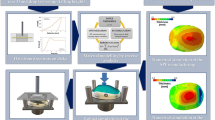Abstract
The multi-point forming (MPF) process of spherical surface parts of titanium alloy retiary sheet and titanium alloy sheet metal with different thickness and curvature radius was simulated by an explicit finite element software. Contradistinctive analysis between retiary sheet and sheet metal forming parts with different modes were done. The simulation results show that under the same forming conditions, titanium alloy retiary sheet is not easy to wrinkle and springback, whereas it is easy to form. The reason for differences in the formability of above-mentioned sheet metal is also analyzed. A non-wrinkling limited graph and a fracture critical graph for spherical surface parts of retiary metal sheet and metal sheet were obtained. Finally a forming test of titanium alloy cranial prosthesis was done in MPF press. Testing results indicate the customized 3D curved surface of prosthesis can be adequately shaped and the forming quality was guaranteed.
Similar content being viewed by others
References
Yang F, Li W, Luo L (2002) The forming of Ti sheet before surgery. Acta Academic Medicinal Jiangxi 70, (China)
Li M, Nakamura K (1992) Study of the basic principles (1st report: Research on multi-point forming for sheet metal). Proc of the Japanese spring conf. for technology of plasticity 519–522
Li M, Liu Y, Su S, Li G (1999) Multi-point forming: a flexible manufacturing method for a 3D surface sheet. J Mater Process Technol 87:277–280 DOI 10.1016/S0924-0136(98)00364-1
Liu C, Li M, Fu W (2008) Principles and apparatus of multi-point forming for sheet metal. Int J Adv Manuf Technol 35:1227–1233 DOI 10.1007/s00170-006-0802-1
Cai Z, Li M (2002) Multi-point forming of three- dimensional sheet metal and the control of the forming process. Int J Press Vessels Piping 79:289–296 DOI 10.1016/S0308-0161(02)00017-0
Liu W, Jia S, Zhang C, Li M (2007) Generation and suppression of local severe plastic deformation in sectional multi-point forming. Int J Adv Manuf Technol 32:705–710 DOI 10.1007/s00170-005-0390-5
Li MZ, Cai ZY, Sui Z, Yan QG (2002) Multi-point forming technology for sheet metal. J Mater Process Technol 129:333–338 DOI 10.1016/S0924-0136(02)00685-4
Chen J, Li M, Liu W, Wang, C-T (2005) Sectional multipoint forming technology for large-size sheet metal. Int J Adv Manuf Technol 25:935–939 DOI 10.1007/s00170-003-1924-3
Chen X, Cai Z, Li M (2005) Numerical simulation of wrinkling in multi-point forming for sheet metal without blank holder. Transactions of the Chinese Society of Agricultural Machinery 36:330–333 (China)
Wei G, Wagoner RH (2004) Die design method for sheet springback. Int J Mech Sci 46:1097–1113 DOI 10.1016/j.ijmecsci.2004.06.006
Author information
Authors and Affiliations
Corresponding author
Rights and permissions
About this article
Cite this article
Fuxing, T., Mingzhe, L., Zhongyi, C. et al. Formability analysis on the process of multi-point forming for titanium alloy retiary sheet. Int J Adv Manuf Technol 41, 1059–1065 (2009). https://doi.org/10.1007/s00170-008-1548-8
Received:
Accepted:
Published:
Issue Date:
DOI: https://doi.org/10.1007/s00170-008-1548-8




